#in which i make a la la land and ocean's eleven reference and generally just spew praise and swear??
Explore tagged Tumblr posts
Text
ummm excuse me but this little project as you call it was absolutely amazing? the way your completely nailed so many different aspects of bradley's character were unfucking real and amazing (i haven't seen a couple of them ever brought up in fics before but have had the thought percolating in my mind so wowowow). couple lighter/smaller things before i really get into the in-depth, works cited analysis 😉
first of all reader and her inner thoughts at work and feeling unappreciated and unfulfilled really hit home for me and was something i strongly resonated with - happy that segment was the he loves me one because it's tough going through that alone and i didn't want that for her 🥺 skipping a little further - wow that car ride was so fucking tense wowowow i was on the edge of my seat waiting to find out what bradley said and daaaaaaamn you don’t say that about your four year long girlfriend to other people?!? my jaw actually dropped! seriously tho a masterclass in building tension! and this one's kinda silly, but the repeated comments of bradley “running hot” were so perfect because as someone who runs hot i also never shut up about it 😉 as mentioned, more below!
The worry then transpires from material to emotional and manifests in the form of the two things you’re most deathly terrified of; being a failure and being a failure who finds herself alone - this hit hard - like right out of the gate, this hit really really hard
Bradley can sense you before he has any indication that you’re home. He joked how he could feel you oceans away when he was on deployment and while you thought that he wasn’t serious (Bradley was a sap and had a tendency to be so tooth-achingly sweet) you know that there’s some truth to it. - he could feel you oceans away i want someone to love me so much they feel me oceans away 🥺
Something inside Bradley loves you so deeply, but he also can’t deny the fact that he loves the praise; the reassurance that he’s a good guy who is always doing the right thing. He’s not doing it for brownie points, “per say”, but the praise does feel nice, and after having to fight tooth and nail to stand out - to be someone and mean something to someone other than his family - the good deeds and the compliments that arose because of them were satiating enough. - this is the most comprehensive summation of bradley's character in a romantic relationship that i've ever read
Your eyes found the glimmer of engagement rings, baby bumps, and phones with family pictures as the home screen. Wearing your undergraduate alma mater’s class ring on your finger seemed infantile, and you made the conscience effort to slip it into the clutch you had been carrying with you the entire night. - oh sweet girl! sweet sweet girl 🥺 i have a feeling i know how this is going to end!
Bradley could be so observant yet so self-absorbed at the same time, and it drove you absolutely nuts…So attuned to your needs but never to your feelings. Same old Bradley. - so attuned to your needs but never to you feelings, harkens back to your point above about him loving the praise and liking to be seen like the good guy, again amazing characterization
He knew that Bob wasn’t giving him a warning look for no reason and that Mickey didn’t wander back into the venue for no reason at all. - this is such an amazing detail, specifically how in-character it is for both bob and mickey. of course bob is generally seen as mr morality in fanon, but adding in mickey to this was so perfect, like i can't articulate exactly why, but it was just 🤌🏻
“Tightest thing I’ve ever put my dick in.” - fuck you bradley! you don't tell other people that! ugh this entire situation made me so stressed and like the anticipation and tension between them in the car of when we were going to get the full flashback??? god i was on the edge of my seat
He hated peer pressure. He hated the way he was acting. He hated the way he was treating you behind your back. He hated the way his friends were laughing. He hated himself more for doing it because you deserved so much better. But clearly, he didn’t feel bad enough to stop. - but clearly he didn't feel bad enough to stop, but clearly he didn't feel bad enough to stop, but clearly he didn't - jesusfuckingchrist screaming crying throwing up fuckkkkkkk this was soooooo
Had he always thought of you this way? Were you always talked about so grossly? So demeaningly? Were you really anything to him other than a warm vagina to pummel his dick in when he was horny? - fuckk fuckk fuckkkkk i really liked how you mentioned a couple times before that while never seeming malicious or deliberate, she has mentioned that she’s sore after sex and that he’s a little rough? and like idk it just added something extra to this for me? and like all the demeaning comments she's had at work and like knowing that your own boyfriend engaged in talk like that? your boyfriend of four years??? goddddd shit fuckkk
If he felt that way about you, felt like you were around just for your body and not for you, what did everyone else think? Was Natasha only friendly because she thought you were too immature to be left alone at gatherings? Did Rueben and Mickey actually give a shit about what you had to say when they asked about your work? Did Jake and Javy even know your name? Did your boyfriend even like you? - again! back to her two worries from the beginning!
“What the fuck do you think we talk about then? Huh?” Bradley’s pointed tone sends a slight sliver of fear down your spine at his annoyance. “Do you think we sit on those fucking carrier ships in the middle of the fucking ocean for eight months at a time and talk about what? Girl power and Title IX? How much we love AOC?” - please i actually laughed out loud, but then like?? fuck you bradley men can talk about women plenty without demeaning them???
You spend the next two hours separate from each other, toeing around the house petrified of seeing the other’s face. No fight you had gotten into with one another had ever been this bad in the four years you had been dating, and part of you wonders if this is how relationships begin to fade; how people start to realize that maybe their person wasn’t their person. But you think Bradley is it for you. You’ve always felt that way since coming to know him. Be with him. Have him in the same way he has you. You don’t think you can function without him no matter how much of an ass he’s being to you right now. And sure, you’re independent to a fault and yeah, you don’t always know what’s good for you, but you know one thing definitively, and that thing is that Bradley Bradshaw checks all your boxes despite driving you slightly insane at times. - this was just wonderfully written, like i have nothing else to say but wow she loves him so fucking much
You’re not stupid. You’re not oblivious. In fact, you’re always so painfully aware that it kills you sometimes. You notice how he’s been pulling away. You notice how he’s seemed more reserved and despondent than usual. You notice how he doesn’t kiss your forehead anymore or ask to join you in the shower when you’re both spending your mornings at home together on the weekends. Conversations at the dinner table are neither here nor there as most nights he can’t be damned to make it home to eat with you. For the first time in five years, you had run out of face wash and had to write a note to yourself on your phone to pick some more up from the store the next time you went shopping. Bradley had watched you type it out and his sagging shoulders wore disappointment on them. You knew. - you notice, you notice, you notice, shifting to you knew and bradley's think about his mom saying 'a woman knows' AMAZING perfect writing
But yet you cling to what little time you know you have left with him. How you know that you’ll never get to sleep beside him again. How you know that you’ll never get to snuggle into his UVA blanket. How you know that you’ll never visit the Hard Deck or the base or any spaces where Rooster Bradshaw exists freely. - you cling to what you have left with him like can you hear my hear breaking?!?!?
This is the last time he will hold you like this. This is the last time he will know you as well as he does. This is the last time he will ever have the chance to make you miserable. - the last time he will ever have the chance to make you miserable fuckkkkkkkk
Five years and you know how he takes his coffee in the morning. Five years and you compromise regularly about what to keep the thermostat on. Five years and nine weddings you had attended with him. Five years of loving each other and knowing one another in ways that only fiction writers can dream of having someone know them. Five years of feeling like you would die without him. - five fucking years!! i still can't get over that! five fucking years, i'd SPIRAL if i got broken up with after five years because my boyfriend thinks i deserve better??? methinks bradley should go back to that therapist he stopped seeing!!
“I deserve you,” you say, tone dripping with determination and assurance. He’s full-on sobbing now. “You deserve so much better, baby. Why can’t you see it?” “Why can’t you just be better then?” - WHY CAN'T YOU JUST BE BETTER THEN???? i'm crying AGAIN as i type this after my first read! god she is the sweetest girl and deserves the world! bradley! why?!
“Bradley?…Will you still call me every night before I go to sleep so I can hear your voice?” “I can for a little while, baby.” - and that’s when i started ugly crying at 5:10am. literally had to get out of bed and get a tissue to blow my nose jesusfuckingchrist this was so heartbreaking??? and both of them having the realization that they didn't want the other to eventually stop calling, but knowing it's inevitable? god i hate it! it was so beautifully written!
“You’ll find someone who’s an even better best friend than I am,” he sniffles. He hadn’t even noticed that he had started crying again. “Someone who doesn’t make you cry.” - ‘does he make you laugh?’ ‘he doesn’t make me cry’ or at least i think that’s how that ocean’s eleven quote goes (sorry i couldn't resist), this ending???? it was so realistic, which made it all the worse!?!? 🥺 like if i was with my boyfriend for five years!!! and he broke up with me, i'd SPIRAL and also beg him to still be friends? it reminded me of at the end of la la land when mia and sebastian are like 'i'm always gonna love you' 'i'm always gonna love you too' but you know they have to break up in order to achieve their dreams?
‘cause no one breaks my heart like you

“Last times always make him uneasy. He thinks that he should be used to it by now from his track record of being abandoned (willfully or “out of their control” situations alike). None of this should hurt him as deeply anymore.” or Bradley Bradshaw is terrified of commitment and he decides to stop being selfish (even though it’s hard to see).
A/N: Okay so EXTREMELY long time, no see! I’ve been working on this little project since the end of September and have been driving myself crazy in trying to sculpt the words the way that I wanted and how to make this seem as realistic as possible. I appreciate every single person who has been so patient with me and my inconsistent posting and hope you enjoy 19k words of our favorite guy in the sky.
(Year 3)
He loves me. He loves me not.
He loves me.
The strange thing about crying is never knowing when the tears will fall. There’s this burning sensation that comes with it; clearly juxtaposed to the watery mess your eyes want to produce. Your nose burns, your face is hot, and the all-consuming, mind-numbing squeeze of rubberband-like pressure around your temples makes you dizzy.
Keep reading
#bradley fic#in which i make a la la land and ocean's eleven reference and generally just spew praise and swear??#also none of my comments are proof read so i'm sorry if nothing makes sense ✌🏼
1K notes
·
View notes
Text
On Worlds.
We inhabit them. We've christened ours Earth, but there are some who call Middle-Earth their home. I've heard many dashing tales from the Borderlands, and on all too many occasions guested in Azeroth. All these faraway lands are unique in their own right, sporting flora and fauna so diverse it really does make one wonder how such things came to be, whether out of nothing, or out of the wilds of human imagination.
I've always been under the impression that it would take a person too much blood, sweat and tears to fashion one. But here I stand, alone, and I need a place to set my latest overambitious and never-ending enterprise. It's a habit I'd always detested deep down, but came to respect over time, and now I say it is the prospect of making something grand, chipping away at it day and again, that gives me one more reason (among many, mind you) to get up early in the morning, and wonder what aspect of it am I going to work on next.
So it is, that I've been pondering on the sort of a world I would want you, the Player, to quench your wanderlust, and perhaps take your subconscious somewhere it has never travelled.
My research -- that hunt for inspiration, artistically speaking -- took me to media I have and have never ever witnessed, or heard, or read, or seen. I've browsed art, played this game and that; I've watched film and series, and I've brushed the dust off some of my forlorn literature. I've even dared to show up in the local library for once in an embarrassingly long (by a reader's standards) while, and borrow a "manuscript" or two I thought had a few interesting ideas. But, I have to admit, Stack Exchange remains my personal favourite. There are so many great minds there, with an equal knack for world-building, and even more thought-provoking questions granted inspiring answers. I can't recommend it enough.
On to the point, though, and it is that I've compiled a list of "archetypes" to take into consideration building my own world:
Earth-likes
What a surprise, huh? I believe it to be the most widespread archetype, and it is rather self-explanatory. An Earth-like world is more often than not a carbon copy of the blue planet (or our rather milky galaxy), with oceans and continents shuffled a notch to dodge the cosmic copyright, so to speak. It is again most common, and for a good reason: we know plenty about the science that keeps such worlds (and, by extension, our own) spinning, and the life living the way it does. It is a solid point of reference, backed with facts and studies so easy to look up on the web, or anywhere bookish, and it is always oh so tempting to use.
A few notorious examples taken from modern authors include...
...a continent under the influence of Celtic and Germanic myths; known as Middle-Earth of J. R. R. Tolkien.
...the super-continent of Stillness by Nora K. Jemisin.
...the Present World, to some extent a mirror of ours, and found in Kentaro Miura's Berserk.
...or the unforgiving deserts of Arrakis, credited to Frank Herbert.
...or Faerun, the iconic setting of Forgotten Realms.
...or even the Journey, courtesy of thatgamecompany, and the dunes one has to slide down rushing to the mountain's peak.
If at least two of the above ring a bell, you may have an idea of what brings all these worlds together, and by extension, what I think constitutes an Earth-like world. If not, then let me illustrate my point instead:
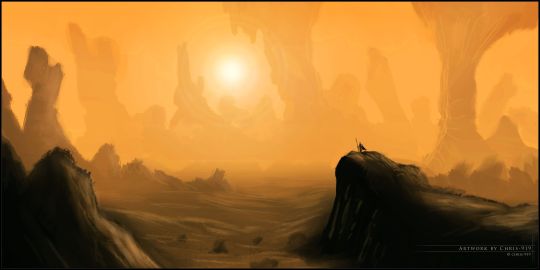
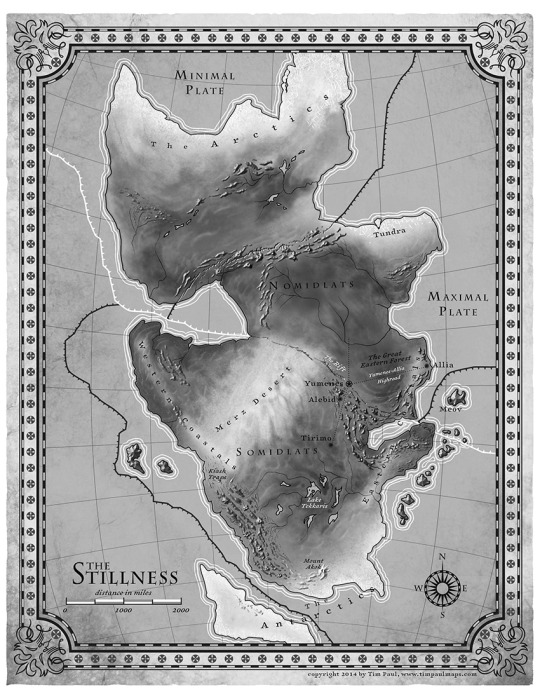
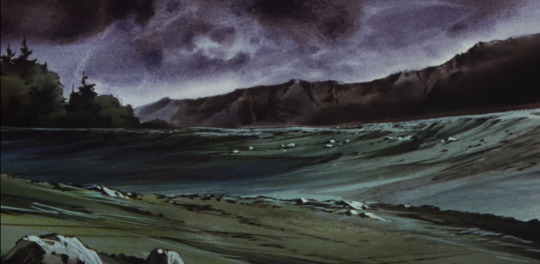
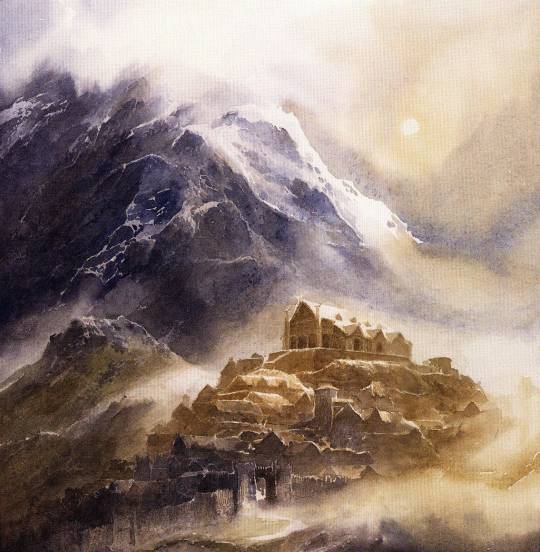
Go on, draw a comparison! It wouldn't take a particularly perceptive eye to notice that even a seemingly outlandish example, the desert planet of Arrakis, shines features not too unlike those we may find here on Earth, albeit "turned up to eleven," for the lack of a better expression. They are planets filled with oceans, and continents in between the oceans, most of them, and in general they follow the same rules we follow in our universe: desert storms rise as the wind blows, plates collide to erect mountains, and sentient life is soon to usher in an age of civilisation. Physics and passage of time progress the world as you would expect them to.
Naturally, there will be a degree of variation between Earth-likes. George Martin's Westeros, for one, is an otherwise conventional continent subject to unconventional seasons, some so abnormal they shape entire cultures -- consider the Long Night, for instance, and the impact it had on the Westerosi folklore.
Let's touch on Arrakis again: it is too an Earth-like world at the core, that suffered from a speculated misfortune of a near-miss encounter with a comet, and what once might have been an arid and bountiful world has now been left a scorching desert inhabited by massive sandworms that have evolved to swim through the sands as though they were oceans, and gobble up the teeny-tiny human wanderers crossing their "soil." A few similar worlds come to mind: Kharak, just as extreme and featured in the Homeworld series, and the much more famous Tatooine, the brainchild of George Lucas.
This big quirk -- extreme weather, unpredictable seasons, or morphed geology, or fictional species -- I prefer to dub "the Twist." It is something, a phenomenon or fact of life, that sets this world apart from ours -- something you can use to suggest that the world at hand is its own, and not Earth put in an alternate reality. Extreme biomes of Arrakis or Kharak, and bizarre seasons of Westeros, are just two examples of the Twist. Magic and magical beings found on Azeroth, or in Faerun, is another.
While the Twist is found in all archetypes, I'm of the opinion that Earth-likes depend on it more than others. Take away the Twist, and you will be left with yet another exoplanet, abiding by the rules we all know and, to be frank, find them too mundane to entertain us, or to leave a lasting memory.
As you'd expect, this was the first archetype I visited and considered for my game. The Twist I wish to feature, to go hand in hand with game mechanics I have devised, is the marriage (or clash, depending on your point of view) of science and magic, and the many ways cultures practicing either-or-both would balance them out, or tip the scales in one's favour if they so desire. I'm also very keen on endangering the Player on their journey, which I want to be perilous, and for it to matter more than the destination. Think of it as a world of vagabonds and gallivants, travelling from one bizarre place to a place twice as otherworldly, and embarking on life-threatening quests.
I've considered several worlds, most notably Kharak -- whose native species, the Kushan, traverse it on trucks and jeeps and other sand-crawling machinery. Cities on that scorched planet exist as only safe havens around, surrounded with lifeless sands, and to make it from one city to another is a dangerous affair indeed. The theme resonated with me quite a bit, but I did not find desert planets a good choice for my game, for many reasons:
It is, as the name suggests, a giant desert. There aren't that many biomes (just two, in fact, if you count largely mechanical cities as one) for the Player to explore, and there is little challenge in generating them on the fly, as opposed to a more varied world.
Throwing in arid biomes we discover in worlds like Middle-Earth or Narnia, or Faerun, felt far too conventional to me, and in my mind there would not be much room for an apocalyptic event so crippling as to make exploring this world nigh fatal.
Even if I dodged the desert altogether and rolled with a different biome or biomes, I'd still have to balance between two problems I doubt are easy to solve: featuring more biodiversity in a fundamentally monolithic environment, or more extremes in an Earth-like world that would not fit in very well.
Banality. Banality was a major concern for me, as there are oh so, so many Earth-likes out there in the industry, and the last thing I wish for my little side project is to offer yet another one. No sir!
Scope was the last but nevertheless just as important. It is difficult to fill up a giant continent, or continentS, with enough quests and points of interest to keep the Player invested. It is hard enough to produce enough scripted content, a la World of Warcraft, and it is harder still to delegate the creative matters to an automaton (Talking about you, Left 4 Dead!). Earth-likes, to my understanding, necessitate imposing scale, that I can not hope to achieve neither alone nor in company.
So I scratched this archetype off my list, and again I went searching every nook and cranny of the game industry and beyond for patterns and clues to make into archetype...
Otherlands
Perhaps not the best title to describe a world so otherworldly as to defy all laws native to our universe, but I nonetheless thought it described what I had in mind for such worlds best. Exotics, Otherlands, Alternate Realities, you name it: they spit on the natural laws we've always known, and turn what we consider to be natural upside down, from a relative point of view (I'd image they'd think we earthlings bend their ideas of what is natural, vice versa). They more often than not have so little in common with a conventional; continental world, that as a Player, you ought to be born anew, in a sense, as you have to come to terms with the new reality, and learn the rules alien to your human brain-box.
While not so abundant in fiction or film, there is an unexpected plethora of otherworldly examples found in video games. I suspect, as little more than a humble writer and not at all a qualified game designer, that the blame (the reason, rather) is at least in part to be pinned on the freedom of mechanics worlds detached from all physical boundaries allow. You're no longer on Earth; seldom even in our universe, and more often in a dimension forged by game designers to fulfill a very blunt purpose: to serve the gameplay, in full. I'd imagine it is times easier to set a game built on mechanics hostile to laws of physics somewhere abstract; mallable, in a way, to the designer's whim.
Thinking of examples took me to these fine pieces of digital entertainment:
William Chyr's Manifold Garden is, to me, a quintessential Otherland. It is set in an abstract world wrapping on itself, juxtaposing impossible geometry against Euclidean space. About the only link to our reality it maintains is the presence of gravity. Look up and down, try interacting with the objects or solving the puzzles, and you will very soon understand this is NOT the realm accomodative of your earthly instincts.

Alice: Madness Returns, too, features an Otherland (not Otherlands, fellow Alice fans!), a level set among the clouds, far above in the sky -- none other than Cardbridge! Playing cards dwell there, and glide along the windy streams to form marvellous paper castles in the sky, and bridges, and gates for Alice to cross on her way to the evil (is she really?) Queen's heartful (quite literally) domain. Like in Manifold Garden, physics still permeates this world, but the only "actor" it appears to affect is Alice herself. All that surrounds her, on the other hand, behaves in a way we would think odd.
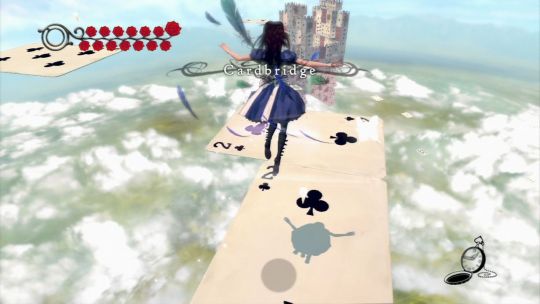
Oddly enough, Valve's Ricochet is one more example of an Otherland, the way I see it. It's set in a pitch black void, a pocket dimension of a sort, and constricts its gunslinging inhabitants to a small archipelago of quasi-futuristic-looking platforms. It is in many ways abstract and disconnected from what we would brand a "real" world; akin more to a simulation than something even an advanced civilisation would be able to orchestrate in the vacuum of deep space. It instead serves a solitary purpose: to be an open and clear arena for the Players to pull off dextereous ricochets and physics-bending leaps from one spot to the next. There are no other earthly rules to govern this world, and beyond the dark arena is the thrice as dark abyss.
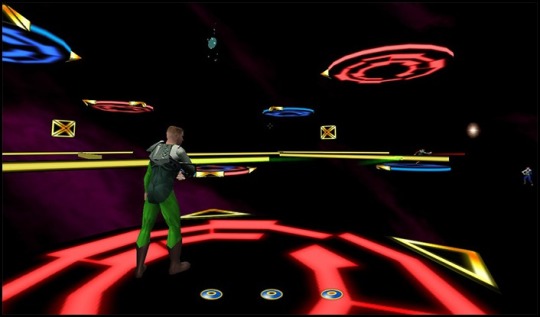
Of course, by this logic, one could consider more abstract games along the lines of Tetris Effect or even Pinball Dreams, to also fit under the same umbrella of otherworldness, and I reckon they would be right. Both games take place in places foreign to our expectation for a, dare I say, traditional setting. This is not to say, oh no, that Otherlands belong to just the games -- far from it! Otherlands are to be found in many other media.
Off the top of my head, I'd count that one scene from the cult-classic 2001: A Space Odyssey, as a "classic" Otherland in a mind-boggling nutshell:

The message I'm trying to convey, if not clear, is that Otherlands are very stubborn, and insistent on breaking you as an earthly thinker; to augment your mind and let it comprehend and utilise the new reality and the rules it enforces, like one would use the laws of our universe. "When in Rome," is the mantra they will have you etch into memory, until you think and interact with it as though you had never known another home.
The entire world, in other words, is one big Twist, standing in stark contrast to the little twists applied here and there to an Earth-like dimension. Furthermore, one could even assert that the Twist in an Otherland is turned on its head -- whereas in an Earth-like Twists were other-landish phenomena many in number but little in scope -- the Twists in an Otherland are instead few and far between, and grounded in reality. They are the links linking an Otherland to the Earth-like law. Say, physics would be very much expected in an Earth-like world, but treated as an exotic Twist in an Otherland.
To be a little more precise, an Otherland does not bother to stay true to the mechanics we think mundane and natural. It instead moulds or kills them outright, and throws itself at the mercy of the designer's wants and wishes.
Otherlands were an option, but not the option, that I'd choose for my world. I cherish the freedom they bestow upon you as a designer, but it alone did not convince me to opt for this archetype. Simply put, the downs outweighed the ups:
The world I wish to create will host fantasy far too Tolkien-esque to distance so much from Earth and earthly law. There is, in my view, a strong pull among many dungeon-crawling aficionados towards fantasy, and fantasy I will deliver. My own strain of fantasy, to be clear, but it will nevertheless mandate a degree of reality deemed by me too Earth-like to belong in an Otherland. I just can not see, at this time, a world of fantasy that is also an Otherland, not if I want my world to radiate welcoming familiarity.
This game being an open-ended RPG, it is difficult for me to envision it in an abstract environment. It calls, as I see it, for landmarks sensible to someone never ever "tainted" by the quirks of Otherlands, familiar and homely in a way, based in laws of physics and around points of interest grounded in our reality. Elevating it to be the Twist of an Otherland, brings the latter much closer to an Earth-like, but not quite. Neither this nor that, if you will, and that in turn leads me to the next and last archetype...
Near-Earths
Should you ever run into the same predicament as yours truly did in the paragraph above, I'd strongly advise you to consider Near-Earths. Not entirely Earth-like, but also too Earth-like to fit as an Otherland, a Near-Earth world is based to some considerable extent in the laws and traits of an Earth-like. It takes the best of both worlds -- mind-boggling Twists of an Otherland and experiential familiarity of an Earth-like -- and mixes them up to shape up something in-between.
Near-Earth remains ultimately an extension of an Earth-like world at its core, but to set itself apart it puts an emphasis on large-scale Twists -- that would be considered too outlandish for an Earth-like. One popular trope among Near-Earths is to feature earthly topology, strewn around the universe in the form of isles or even whole continents. Fundamental laws that define an Earth-like it bends to a fictional degree, but preserves the essentials, such as planets or stars or faimiliar dimensions, that make up our universe. Thus the link between our universe and that lives on, and it's easy for a newcomer to the world to find their way around with little to no hand-holding required.
I can't help but conjure up a few shots from Treasure Planet, which I gather needs no introduction, to illustrate my line of thought. Take one of the more iconic stills from this flawed masterpiece, R.L.S. Legacy docked at the spaceport of Crescentia:
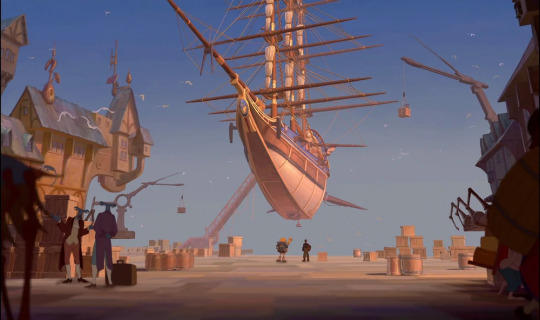
It is in many ways familiar, I think, to anyone who has ever been to any run-of-the-mill harbour, except that ginormous frigate appears to stay suspended mid-air, not even ropes to hold it in place, and not at all swaying side to side on the high seas as one would assume. No, in this universe carpenters and shipwrigts build 18th century vessels propelled by internal combustion engines to fly through the breathable expanse that they call Ethereum. Indeed, there it is possible to breathe in space, so long as one stays careful not to lean too much on the taffrail and fall into the Ethereum proper, doomed forever to be a cosmic castaway.
Treasure Planet is very representative of a Near-Earth world, as I reckon the aforementioned scene proves. While grounded in culture and (partly) science of our universe, it strays a lot from what our scientists would deem feasible, to the point that it is fundamentally different from our universe in some respect, such as there existing a breatheable atmosphere everywhere in their universe, but not so fundamental as to defy every law of science we know in our world. Physics, and planets, and other celestial bodies and phenomena still exist there, albeit altered in a variety of ways.
Another such example would the High Wilderness, that we're told to travel aboard a literal locomotive, in the brilliant game and one of my many favourites -- Sunless Skies:
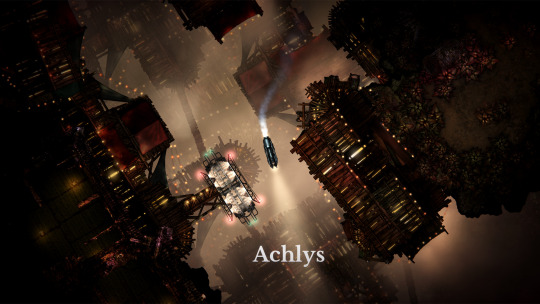
It, too, features all the same biomes and structures and many laws with a basis in our universe, and like Treasure Planet, it introduces a major twist: the space beyond the confines of Earth (which does exist in Sunless Skies, and generally follows our history with significant deviations perpetrated by Masters of the Bazaar) is an intricate maze of seldom interlocked and often overlapping topology, stacked on top of one another, and filled with an atmosphere reminiscent of Ethereum, breathable but named a different name.
It is still familiar enough to us as earthlings, and it would not take a seasoned Otherlander to pick the thing up and know the rules of play by instinct. Sure, we are driving a locomotive through time and space, and pass by living stars that govern all, called the Judgements, but the spaces we traverse and people we meet and phenomena we witness are not confusing in the slightest. Shrouded in mystery, maybe, but ultimately sensisble if given enough thought. There is not another dimension for us to consider, and impossible geometry wrapping on itself to comprehend, as seen in Manifold Garden. Nay.
On the Judgements, as a side note, I've found them to be an interesting twist in and of themselves: they are intended to be the law-makers that decide what is real in this world, and what is not. Kill, or posses them, and the world will return to a chaotic state, easily a contender for the quintessential Otherland.
One last sample for you to taste would be the city-state of Sigil, the center of all planes in the planar world of Planescape (pardon the tautology!). Also an earthly world in many ways, it departs from tradition by dabbling in the ideas of interplanar travel, and whole planes of existence drifting from place to place depending on the belief of its denizens. Name me a single spiral-shaped medieval town suspended miles in the air:
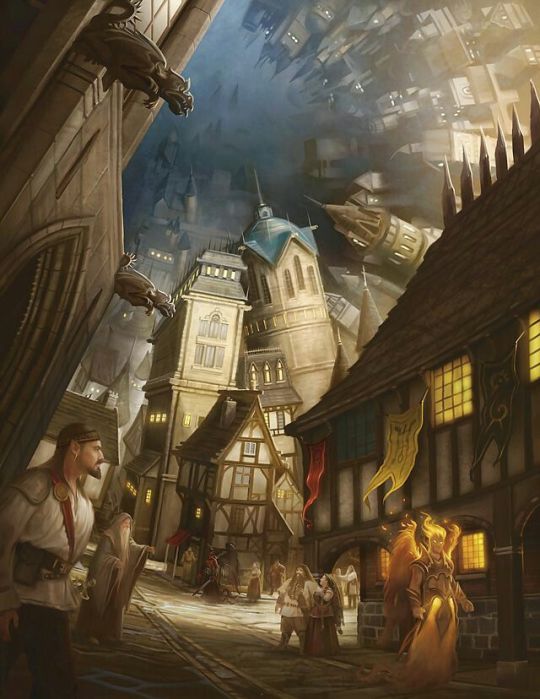
I hope my criteria is now clear, or clear-er, better still if as a day. A Near-Earth has some of its fundamental laws thrown away, or meddled with, but there is always at least some foundation identical to that of an Earth-like.
Enter the Wild
In the end, I had a choice to make; a choice of three options, all of which bore pros and posed cons. Weighing all of them took me several restless nights, about a week in total, and some creative encouragement from a colleague, who suggested I turn to Sunless Skies-esque worlds for inspiration: islands floating in the sky, nurturing islanders and their peculiar settlements. I fell in love with the idea in a heartbeat, and on and on I went searching for references. It implied to me a Near-Earth, and all the marks of distinguishment I outlined before for other archetypes pointed to Near-Earths as the perfect fit for my world.
I settled for a few points of reference, among them...
Variably-sized islands and quasi-continents of Dragon Hungers, complete with pocket cultures and hosts of creatures that dwell there:
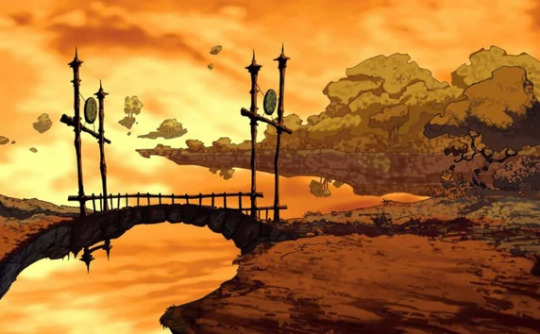
"Outdated" and outlandish means of transportation between the islands, like airships or fire-breathing dragons, a la Sunless Skies:
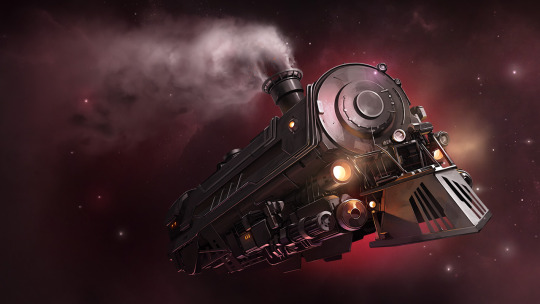
Celestial bodies of Treasure Planet, like black holes or nebulas, making an appearance, though toned down a bit to ditch some of their more destructive and lethal properties. A black hole wouldn't spaghettify you in the blink of an eye, but falling into one will nonetheless bring a swift (albeit not quite so fast and unavoidable) end to your career:
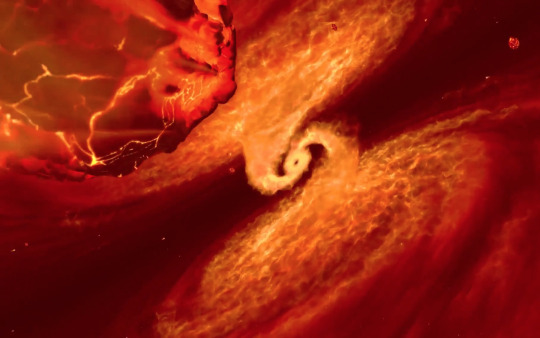
What they amounted to, ultimately, is an amalgamation of varied islands, some as big as a continent, others as small as my balcony, and all sporting ecosystems never-before-seen on most other islands. They are suspended in the sky, fortunate to have a man-friendly atmosphere, with a devilish twist I'd rather keep a secret for the time being.
Wannabe heroes make their living sailing through this sky aboard mighty airships or fire-breathing dragons (among many other means of transportation), from one island and on to the next, undertaking quests and accepting commissions from the locals to earn themselves some sustenance. It's a floating world of vagabonds, gallivanters, and legends-in-the-making.
OR! Those same gallivanters may find a particular island, or spot upon on the island, very tempting to settle on. Indeed, if they so desire, players would be able to adopt a sedentary lifestyle, and see what the wilds beyond the comfort of their heart might bring one treacherously blissful morning...
Us locals have entitled this universe the Wild. Enter at your own risk, traveller, for you may never return. This theme seemed to me like a good middle-ground between all the problems I've outlined reviewing archetypes:
Scope was confined to the typical bounds of an island. Some are bigger than others, no doubt, but all of them are a far cry from the usual dimensions of a continent. A narrow scope, as such, is a scope amiable to developers limited in number, or readiness to tackle an enormous landmass.
Narrowed scope in turn shortens the distance one must travel to leave one point of interest for another. We're feeding two birds with one scone -- there is no need for us, as developers, to fill up the lands betwixt with something for you to do, and you won't have to drag yourself through an overstretchesd piece of half-arsed (pardon my French) filler to finally reach the objective that caught your eye in the first place.
At last, as my colleague pointed out, islands in space are capital. Done before to be sure, that road has been travelled many times (and so were most others), but it is still the Earth-likes that proudly keep at the victorious spree as the dominant archetype among the developers. A Near-Earth to me felt like a fair and much-wanted change of scenery, for once in a blue moon.
A floating world shattered into many habitable pieces by far imposes so many more factors upon the cultures, languages, civilisation, technology, and nature of the wild, that to turn it down in favour of an all-too-researched Earth-like world seemed a lazy way out the massive creative problem, I think, many people of letters and pencil and other trades would be thrilled to approach.
P.S. I do realise all my scribbled judgements are arbitrary, and the lines separating Near-Earth from Earth-likes, from Otherlands, is apparently fine, and entirely subjective. These are little more than my five cents; my five thoughts on the subject, and I personally found grouping these worlds into archetypes a good "bookmark" that I've used and will likely come back to designing my own worlds. Peace.
4 notes
·
View notes
Text
Those Useless Trees — The Valley Oak

A couple of days ago my friend Mike and I decided to go for a hike in Malibu Creek State Park. Having celebrated a friend’s birthday the previous night into the following morning, a good moderately strenuous ramble seemed like just the thing. We were both awed by the park’s stunning vistas as well as its many magnificent valley oak trees, the largest oak species in North America and a species found only in California.

Inside the Malibu Creek State Park
The 3,324-hectare park, although opened to the public in 1976, of course, has a much older history. The first humans to arrive in the area where likely the Chumash, who established the village of Talepop (or Ta’lopop) within what’s now the park. About 3,500 years ago — thousands of years after the Chumash settled the area — the Tongva arrived from the east and the Malibu Creek, which drains the Santa Monica Mountains, became a sort of border between the two nations. Downstream the river flows into the Pacific Ocean at an estuary the Chumash referred to as “U-mali-wu,” meaning “it makes a loud noise there.” The Spanish, who arrived in the 16th century, recorded the name as Malibu.

Languedoc?
Although neither Mike nor I had ever been to the park before, we’d both seen it in many films and television series. The striking Goat Buttes, in particular, have served as a popular setting in Hollywood fictions. Before reading a sign informing us that the outcroppings were in the series, M*A*S*H, I was reminded by the chaparral-covered prominences of a childhood summer spent in Languedoc. After learning that the semi-arid oak landscape had been used to evoke green, temperate Korea for eleven seasons of the long-running Korean War comedy, I was struck by how unlike the scenery reminded me of any I’d seen in Korea, which I visited last summer. Of course, come to think of it, the cast of that show’s hairstyles seemed suspiciously ’70s for a war which took place from 1950-1953.

Coast live oaks on a hill
The valley in which we stood was carpeted with brittle, yellow grasses and scruffy oak trees. Most of the oaks in the oak savanna were coast live oak (Quercus agrifolia), also known as California live oak, those familiar oaks which during the rainy season fleetingly give the landscape of rolling hills on which they often grow the appearance of the Shire. Elsewhere in the park, there are stately sycamores and the southernmost grove of redwoods. There are, naturally, many varieties of native fungi and fauna as well, and during our visit, we observed a small herd of mule deer, various lizards, a covey of quail, a couple of rabbits, a California tarantula, a gracefully gliding heron, a red-tailed hawk, a flock of pigeons, and several other birds which I didn’t recognize.
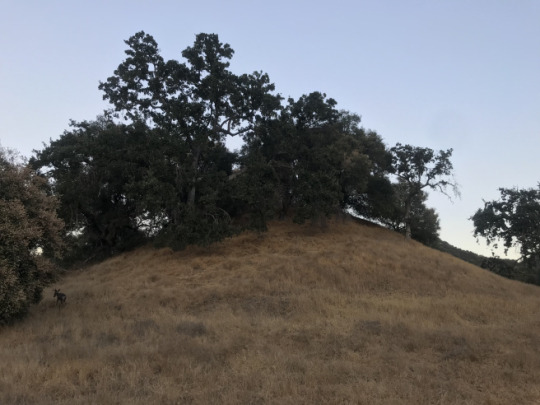
Some of the oaks obviously unlike the others. They were taller, their silhouettes patchier, their branches droopier than the dome-like coast live oaks, the canopies of which spread out like gauzy green umbrellas over the gently rolling hills. As a child growing up in Missouri’s Little Dixie, I roamed the forests and knew my red cedars from my red maples, my black walnuts from my bladdernuts, my corkwoods from my dogwoods, my pawpaws from my possumhaws. I don’t remember learning most of their names and characteristics, though, and because of that, I hoped — however unrealistically — that I’d over time somehow simply absorb a similar knowledge Southern California’s trees. Having now lived in Southern California longer than anywhere else, I have unfortunately found that I have to make an effort to learn them.
I observed the oaks that were not coast live oaks. Whereas the leaves of the coast live oak are small, shiny, prickly, and look a bit like those of a holly shrub, the leaves of these oaks were lobed and looked almost leathery, faintly fuzzy. The leaves were clustered rather than spread across the branches’ tips. The bark was sort of silvery brown and almost uniformly wrinkled whereas the trunks and branches of the coast live oaks appear contorted and gnarled. It was clear that these were not coast live oaks — but I was no closer to identifying them than I had been when Mike had asked me what they were and so I turned to PlantSnap, an app which has, since downloading, successfully identified about 30% of the plants I’ve used it to recognize. It also identifies fungi — but with a track record like that, I wouldn’t use it for foraging unless I was completely OK with a painful death. This time the app proved successful, however, notifying me that the tree was most likely a Quercus agrifolia, or valley oak (it was) or, perhaps, a staghorn fern or loquat (it was obviously not). Valley oaks are also known as robles, as in Paso Robles.
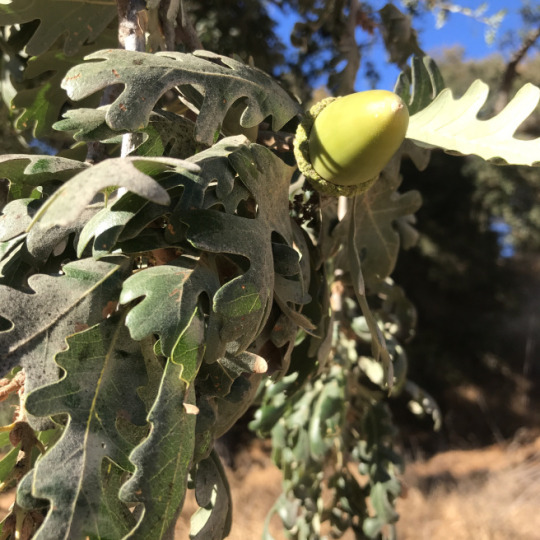
I was struck by the appearance of the valley oaks acorns, which were considerably longer than those I was accustomed to. They provide food for, among other animals, acorn woodpeckers, California ground squirrels, California scrub jays, and yellow-billed magpies. Historically, they were also an important food source for the Chumash, who never developed agriculture as they were able to live comfortably off of what they foraged and hunted.
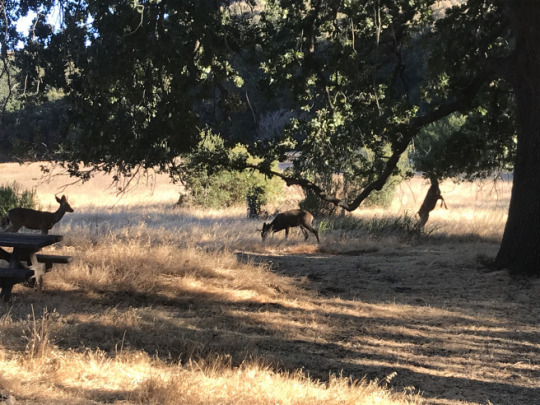
Mule deer eating valley oak leaves
The woody parts of the valley oak support California gall wasp, red cone gall wasp, and Chionodes petalumensis. As we approached a beckoning oak woodland, we stopped to watch a large family of mule deer, one of whose members spent a great deal of time standing on his hind legs and helping himself to the leaves of a large tree.
The roots of the valley oak have intimate symbiotic associations with many of the region’s mycorrhizal fungi which are essential to their survival — and one of the main reasons Southern California should favor the planting of native trees over imports like the pepper trees, goldenrains, jacarandas, bottle brushes, &c which, although drought tolerant, are simply incapable of slotting into an ecosystem which evolved over millions of years without them.
The valley oak is endemic to California, where its range stretches along the valleys and foothills of San Diego County in the south to Sikiyou County in the north. They live to be up to 600 years, which means that the oldest trees were alive during the fall of Constantinople, the invention of the printing press, the domination of Central Asia by Tamerlane’s Timurid Empire, and closer to home, the rise of the Inca and Aztec empires.
Until it fell on 1 May 1977, the tallest valley oak was the so-called “Hooker Oak,” which stood until then in Chico. Because its trunk had a massive diameter of 8.8 meters, its age was at the time estimated to be over 1,000 years old. However, once dead it was determined that the tree owed its girth to the fact that it was in fact two specimens, both of roughly 325 years of age, which had long ago grown together into one. It appeared in many films where it proved a natural in its many roles as a tree.
The Adventures of Robin Hood (1938), co-starring the Hooker Oak
The current tallest valley oak is the so-called “Henley Oak,” a specimen which towers 47 meters above the floor of the Round Valley in Covelo. It is named after Thomas J. Henley, a one-time Superintendent of Indian Affairs notable for opening the region to European-American settlers in defiance of a federal order which had promised the land to Native Americans, resulting in a great deal of regrettable bloodshed between indigenous Californians and immigrants. The tree is believed to be more than 500 years old, meaning it sprouted from an acorn and was possibly producing its own well before the first Spanish galleon, San Salvador, sailed along the coast.

The Henley Oak (source unknown)
Mike and I turned back after reaching Rock Pool, and again we crossed the valley featured in M*A*S*H. This time, surprisingly, I did find myself somewhat reminded of Korea — or at least of Korean (and Chinese) landscape painting. By this time, the sun had set and the gold hour was transitioning to blue. The oak woodland seemed to be climbing up the base of the improbably steep sandstone hillsides. Tipping the scales of perception, perhaps, was the presence of a Korean family attempting to take photos of a toddler with the scenery as a backdrop.

Korean landscape painting? Oak woodland at the base of low mountains
I sometimes have a physical sensation of being pulled into the woods and the longer I looked at the trees, the stronger the pull seemed to grow. I had to fight the urge to enter the forest because the park had officially closed the moment the sun sank behind the horizon and currently, there is no overnight camping because in June, 35-year-old Tristan Beaudette was shot to death in the tent he was sharing with his two young daughters. Since then, rumors and other reports of gunfire in the park have emerged both following the murder and stretching back to 2016 and there’s an ongoing investigation.

Vacant campsite under a canopy of oak trees)
Hopefully, the murderous gunman will be caught and peace and campers will again return to the park. It looks like a really wonderful place to pitch a tent for a weekend, perhaps do a bit of forest bathing, or even just contemplate the scenery. As we continued toward the exit, the crescent moon (which had hung in the sky throughout our day) was now shining brightly and bats were flitting about in search of a meal. We hurried our pace and left the park without incident.
Eric Brightwell is an adventurer, writer, rambler, explorer, cartographer, and guerrilla gardener who is always seeking paid writing, speaking, traveling, and art opportunities. He is not interested in generating advertorials, cranking out clickbait, or laboring away in a listicle mill “for exposure.”
Brightwell has written for Angels Walk LA, Amoeblog, Boom: A Journal of California, diaCRITICS, Hidden Los Angeles, and KCET Departures. His art has been featured by the American Institute of Architects, the Architecture & Design Museum, the Craft & Folk Art Museum, Form Follows Function, Los Angeles County Store, the book Sidewalking, Skid Row Housing Trust, and 1650 Gallery. Brightwell has been featured as subject in The Los Angeles Times, Huffington Post, Los Angeles Magazine, LAist, CurbedLA, Eastsider LA, Boing Boing, Los Angeles, I’m Yours, and on Notebook on Cities and Culture. He has been a guest speaker on KCRW‘s Which Way, LA? and at Emerson College. Art prints of Brightwell’s maps are available from 1650 Gallery. He is currently writing a book about Los Angeles and you can follow him on Ameba, Facebook, Goodreads, Instagram, Mubi, Twitter, and Weibo.
Click here to offer financial support and thank you!

Source: https://ericbrightwell.com/2018/09/18/those-useless-trees-the-valley-oak/
0 notes
Text
Those Useless Trees — The Valley Oak

A couple of days ago my friend Mike and I decided to go for a hike in Malibu Creek State Park. Having celebrated a friend’s birthday the previous night into the following morning, a good moderately strenuous ramble seemed like just the thing. We were both awed by the park’s stunning vistas as well as its many magnificent valley oak trees, the largest oak species in North America and a species found only in California.

Inside the Malibu Creek State Park
The 3,324-hectare park, although opened to the public in 1976, of course, has a much older history. The first humans to arrive in the area where likely the Chumash, who established the village of Talepop (or Ta’lopop) within what’s now the park. About 3,500 years ago — thousands of years after the Chumash settled the area — the Tongva arrived from the east and the Malibu Creek, which drains the Santa Monica Mountains, became a sort of border between the two nations. Downstream the river flows into the Pacific Ocean at an estuary the Chumash referred to as “U-mali-wu,” meaning “it makes a loud noise there.” The Spanish, who arrived in the 16th century, recorded the name as Malibu.

Languedoc?
Although neither Mike nor I had ever been to the park before, we’d both seen it in many films and television series. The striking Goat Buttes, in particular, have served as a popular setting in Hollywood fictions. Before reading a sign informing us that the outcroppings were in the series, M*A*S*H, I was reminded by the chaparral-covered prominences of a childhood summer spent in Languedoc. After learning that the semi-arid oak landscape had been used to evoke green, temperate Korea for eleven seasons of the long-running Korean War comedy, I was struck by how unlike the scenery reminded me of any I’d seen in Korea, which I visited last summer. Of course, come to think of it, the cast of that show’s hairstyles seemed suspiciously ’70s for a war which took place from 1950-1953.

Coast live oaks on a hill
The valley in which we stood was carpeted with brittle, yellow grasses and scruffy oak trees. Most of the oaks in the oak savanna were coast live oak (Quercus agrifolia), also known as California live oak, those familiar oaks which during the rainy season fleetingly give the landscape of rolling hills on which they often grow the appearance of the Shire. Elsewhere in the park, there are stately sycamores and the southernmost grove of redwoods. There are, naturally, many varieties of native fungi and fauna as well, and during our visit, we observed a small herd of mule deer, various lizards, a covey of quail, a couple of rabbits, a California tarantula, a gracefully gliding heron, a red-tailed hawk, a flock of pigeons, and several other birds which I didn’t recognize.

Some of the oaks obviously unlike the others. They were taller, their silhouettes patchier, their branches droopier than the dome-like coast live oaks, the canopies of which spread out like gauzy green umbrellas over the gently rolling hills. As a child growing up in Missouri’s Little Dixie, I roamed the forests and knew my red cedars from my red maples, my black walnuts from my bladdernuts, my corkwoods from my dogwoods, my pawpaws from my possumhaws. I don’t remember learning most of their names and characteristics, though, and because of that, I hoped — however unrealistically — that I’d over time somehow simply absorb a similar knowledge Southern California’s trees. Having now lived in Southern California longer than anywhere else, I have unfortunately found that I have to make an effort to learn them.
I observed the oaks that were not coast live oaks. Whereas the leaves of the coast live oak are small, shiny, prickly, and look a bit like those of a holly shrub, the leaves of these oaks were lobed and looked almost leathery, faintly fuzzy. The leaves were clustered rather than spread across the branches’ tips. The bark was sort of silvery brown and almost uniformly wrinkled whereas the trunks and branches of the coast live oaks appear contorted and gnarled. It was clear that these were not coast live oaks — but I was no closer to identifying them than I had been when Mike had asked me what they were and so I turned to PlantSnap, an app which has, since downloading, successfully identified about 30% of the plants I’ve used it to recognize. It also identifies fungi — but with a track record like that, I wouldn’t use it for foraging unless I was completely OK with a painful death. This time the app proved successful, however, notifying me that the tree was most likely a Quercus agrifolia, or valley oak (it was) or, perhaps, a staghorn fern or loquat (it was obviously not). Valley oaks are also known as robles, as in Paso Robles.

I was struck by the appearance of the valley oaks acorns, which were considerably longer than those I was accustomed to. They provide food for, among other animals, acorn woodpeckers, California ground squirrels, California scrub jays, and yellow-billed magpies. Historically, they were also an important food source for the Chumash, who never developed agriculture as they were able to live comfortably off of what they foraged and hunted.

Mule deer eating valley oak leaves
The woody parts of the valley oak support California gall wasp, red cone gall wasp, and Chionodes petalumensis. As we approached a beckoning oak woodland, we stopped to watch a large family of mule deer, one of whose members spent a great deal of time standing on his hind legs and helping himself to the leaves of a large tree.
The roots of the valley oak have intimate symbiotic associations with many of the region’s mycorrhizal fungi which are essential to their survival — and one of the main reasons Southern California should favor the planting of native trees over imports like the pepper trees, goldenrains, jacarandas, bottle brushes, &c which, although drought tolerant, are simply incapable of slotting into an ecosystem which evolved over millions of years without them.
The valley oak is endemic to California, where its range stretches along the valleys and foothills of San Diego County in the south to Sikiyou County in the north. They live to be up to 600 years, which means that the oldest trees were alive during the fall of Constantinople, the invention of the printing press, the domination of Central Asia by Tamerlane’s Timurid Empire, and closer to home, the rise of the Inca and Aztec empires.
Until it fell on 1 May 1977, the tallest valley oak was the so-called “Hooker Oak,” which stood until then in Chico. Because its trunk had a massive diameter of 8.8 meters, its age was at the time estimated to be over 1,000 years old. However, once dead it was determined that the tree owed its girth to the fact that it was in fact two specimens, both of roughly 325 years of age, which had long ago grown together into one. It appeared in many films where it proved a natural in its many roles as a tree.
The Adventures of Robin Hood (1938), co-starring the Hooker Oak
The current tallest valley oak is the so-called “Henley Oak,” a specimen which towers 47 meters above the floor of the Round Valley in Covelo. It is named after Thomas J. Henley, a one-time Superintendent of Indian Affairs notable for opening the region to European-American settlers in defiance of a federal order which had promised the land to Native Americans, resulting in a great deal of regrettable bloodshed between indigenous Californians and immigrants. The tree is believed to be more than 500 years old, meaning it sprouted from an acorn and was possibly producing its own well before the first Spanish galleon, San Salvador, sailed along the coast.

The Henley Oak (source unknown)
Mike and I turned back after reaching Rock Pool, and again we crossed the valley featured in M*A*S*H. This time, surprisingly, I did find myself somewhat reminded of Korea — or at least of Korean (and Chinese) landscape painting. By this time, the sun had set and the gold hour was transitioning to blue. The oak woodland seemed to be climbing up the base of the improbably steep sandstone hillsides. Tipping the scales of perception, perhaps, was the presence of a Korean family attempting to take photos of a toddler with the scenery as a backdrop.

Korean landscape painting? Oak woodland at the base of low mountains
I sometimes have a physical sensation of being pulled into the woods and the longer I looked at the trees, the stronger the pull seemed to grow. I had to fight the urge to enter the forest because the park had officially closed the moment the sun sank behind the horizon and currently, there is no overnight camping because in June, 35-year-old Tristan Beaudette was shot to death in the tent he was sharing with his two young daughters. Since then, rumors and other reports of gunfire in the park have emerged both following the murder and stretching back to 2016 and there’s an ongoing investigation.

Vacant campsite under a canopy of oak trees)
Hopefully, the murderous gunman will be caught and peace and campers will again return to the park. It looks like a really wonderful place to pitch a tent for a weekend, perhaps do a bit of forest bathing, or even just contemplate the scenery. As we continued toward the exit, the crescent moon (which had hung in the sky throughout our day) was now shining brightly and bats were flitting about in search of a meal. We hurried our pace and left the park without incident.
Eric Brightwell is an adventurer, writer, rambler, explorer, cartographer, and guerrilla gardener who is always seeking paid writing, speaking, traveling, and art opportunities. He is not interested in generating advertorials, cranking out clickbait, or laboring away in a listicle mill “for exposure.”
Brightwell has written for Angels Walk LA, Amoeblog, Boom: A Journal of California, diaCRITICS, Hidden Los Angeles, and KCET Departures. His art has been featured by the American Institute of Architects, the Architecture & Design Museum, the Craft & Folk Art Museum, Form Follows Function, Los Angeles County Store, the book Sidewalking, Skid Row Housing Trust, and 1650 Gallery. Brightwell has been featured as subject in The Los Angeles Times, Huffington Post, Los Angeles Magazine, LAist, CurbedLA, Eastsider LA, Boing Boing, Los Angeles, I’m Yours, and on Notebook on Cities and Culture. He has been a guest speaker on KCRW‘s Which Way, LA? and at Emerson College. Art prints of Brightwell’s maps are available from 1650 Gallery. He is currently writing a book about Los Angeles and you can follow him on Ameba, Facebook, Goodreads, Instagram, Mubi, Twitter, and Weibo.
Click here to offer financial support and thank you!

Source: https://ericbrightwell.com/2018/09/18/those-useless-trees-the-valley-oak/
0 notes